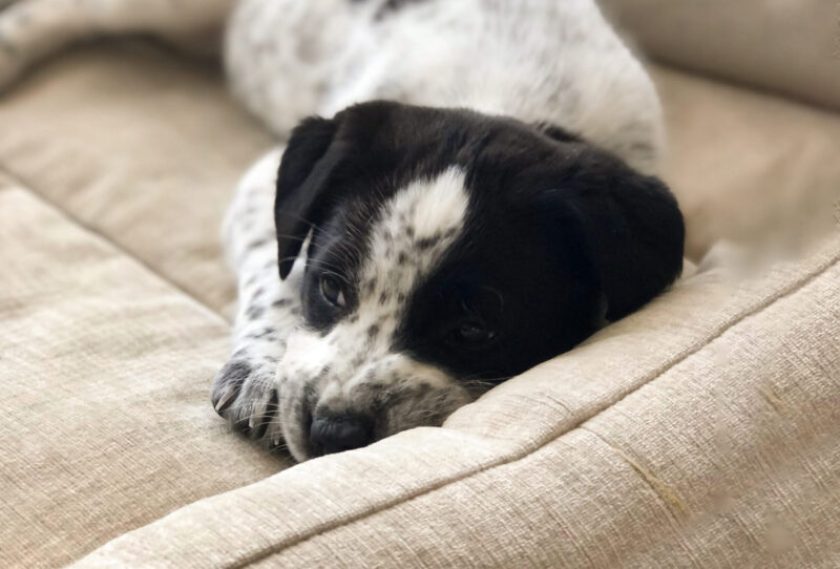Whether you've just brought home a new puppy or recently adopted an adult dog, it's up to you to make sure your new family member stays healthy. One of the most deadly diseases pet parents should know about is canine parvovirus, or parvo. "Parvo is a viral infection that's highly contagious," Dr. Georgette Wilson, medical lead for global diagnostics with Zoetis, tells WideOpenPets.com. "It's one of the few diseases for which all dogs, regardless of size, breed, age, or lifestyle, are at risk. Every dog owner should understand how it's passed and how to protect our dogs."
Parvo most commonly occurs in puppies younger than 5 months old who are not yet fully vaccinated, but adult dogs that haven't been vaccinated can also contract the virus. "It's a devastating illness," says Wilson. "Because some dogs may succumb to the disease even if you get timely treatment, it's essential to make sure your dog is vaccinated to protect him or her from parvo."
So, how do dogs get parvo? Here's what pet parents need to know about the deadly virus and steps they can take to keep their pets safe.
How Dogs Get Parvo

Dogs are exposed to parvo through the mouth and nose after coming in contact with the contaminated feces of an infected dog. Exposure can occur in a variety of ways: Sniffing or licking infected feces outside; playing with other dogs who are infected; or from touching contaminated surfaces such as dog toys, dishes, collars, leashes, and bedding. Pet parents can also bring the virus home on their shoes, clothes, or hands if they've been walking in an area frequented by dogs or petting an infected dog. "The virus can live on surfaces for weeks to months," Wilson explains. "I always tell my pet parents you should expect that it is everywhere in the environment."
New puppy parents need to be extremely careful bringing pets younger than 16 weeks old outside, especially if they live in an area that's frequented by other dogs. Dog that are vaccinated are protected from this disease, but if they come in contact with the virus, they can carry it to other dogs who are not vaccinated. So, for example, if you have a vaccinated dog and a puppy who's too young to receive his shots yet, you'll need to be extra-careful about exposure. "People always want to socialize young dogs, but I don't recommend it until your puppy is fully vaccinated," says Wilson.
Some breeds, for reasons researchers don't understand, are more at risk of developing more severe illness if exposed to parvo. Those breeds include dogs such as Rottweilers, Doberman pinschers, German shepherds, and pit bulls, Wilson warns.
Signs of Parvo

If you think your dog has been exposed to parvo, it's important to know the symptoms to look out for. The earliest signs of parvo in dogs are depression and loss of appetite. Within hours to days, other dangerous symptoms appear including vomiting, often several times per hour, and watery diarrhea, which may also contain blood or mucus.
It's critical for all dogs with these symptoms to receive care ASAP, but puppies are especially vulnerable. "Like babies, puppies have no reserve, so you need to call your vet immediately," says Wilson. "This is an emergency because they're losing fluids and cannot replace them. The symptoms can spiral out of control rapidly." In addition to a physical exam, your vet will do a non-invasive rapid fecal test for diagnosis.
Treatment for Parvo

The most important thing for pet parents to remember if they suspect their puppy has parvo is to seek care immediately. "The sooner, the better," says Wilson. "One of the reasons parvo is challenging to treat is because the dog has to use his own immune system to fight off the virus. We need aggressive supportive care and to treat any secondary issues that can emerge, such as anemia from blood loss."
Supportive care, which addresses your pet's symptoms to help them feel a little less horrible, may include IV fluids, medications to prevent vomiting, and pain medications. Because parvo damages the dog's GI tract, he is also more vulnerable to other illnesses, so antibiotics also may be given to prevent secondary bacterial infections, Wilson explains. Your dog also may need to spend a week or so in the hospital during treatment.
How to Prevent Parvo

Like many other dangerous canine diseases, the best way to prevent parvo is by following the proper vaccination schedule. "Vaccination is the cornerstone of prevention," says Dr. Wilson. "In my experience, I have not seen a fully vaccinated dog get parvo." Talk to your vet about the best vaccine schedule for your dog, no matter how old he is. Puppies typically start a series of parvo shots as part of their DHLPP vaccine around 6 weeks old, with booster shots given every few weeks up to 16 weeks old. For adult dogs whose vaccine history is unknown, they typically receive two shots with boosters every 1 to 3 years. Keeping your dog current on parvo boosters—and all of their vaccinations—is the best way to protect your pup for a lifetime, says Wilson.
Of course, there is the period before a puppy has received all of the parvo shots where it's still vulnerable to infection. During this time, the American Veterinary Medical Association recommends that dog owners use caution when bringing their pet to places where young puppies and other dogs spend time, like pet shops, parks, obedience classes, doggy daycare, kennels, and grooming facilities.




